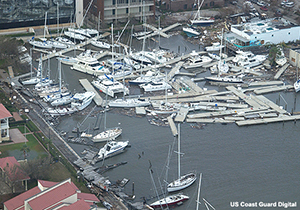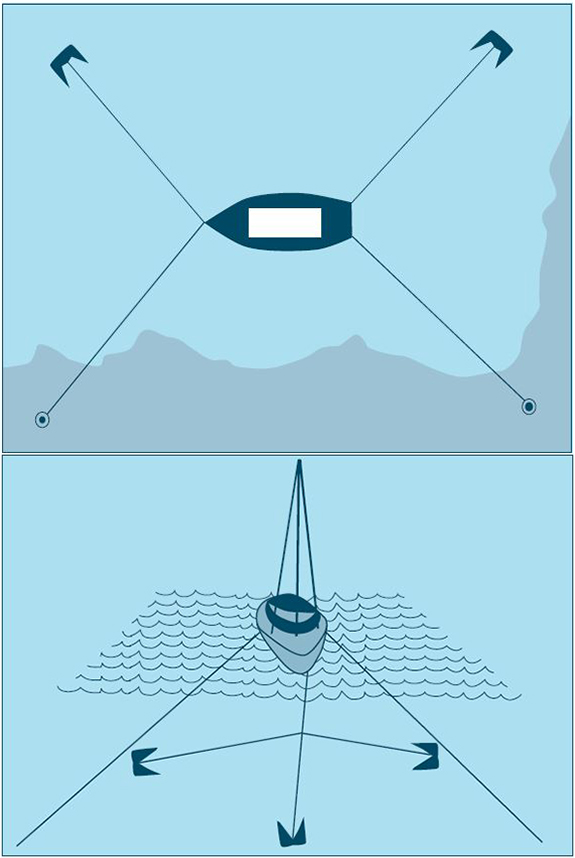Safe Havens and How to Secure Your Boat (Part II)
June 2015
Before you plan to secure your boat on the water, consider whether hauling your boat to higher ground is an option and develop a plan well before a storm is approaching – see Part I of this article for more information. If a large boat cannot be trailered out, there are two basic options that remain: securing the boat in a marina berth or mooring it in a previously identified safe haven. Don’t plan to ride out the storm in your boat – drowned boaters are a common cause of death in hurricanes.
Removing Valuables and Sealing the Boat
 Plan to haul out your boat if possible. Canals and marinas near the ocean experience storm surges which can beat boats against the dock or impale them on pilings. Source: USCG
Plan to haul out your boat if possible. Canals and marinas near the ocean experience storm surges which can beat boats against the dock or impale them on pilings. Source: USCGBoats on shore, in transit, and on the water all need to be stripped of potential flying debris and pollution hazards. Valuable personal effects and the ship’s papers are among the first things that a boat owner may remember to remove from a boat, but any movable item such as canvas, sails, dinghies, galley fuel, cushions, biminis and roller furling sails can become flying debris and should be removed. Take down the mast whenever possible and lash down tillers, wheels, booms, and other items you can’t remove. Secure all hatches and portals and cover windscreens. Remove electronics and shut down the electrical system except the bilge pump if you are on the water. Remove fuels if you are storing the boat on shore.
As you review the tasks needed to strip the boat, create a list of items to remove, and inventory what is left on board. Determine how much time it takes to clear and tie down your boat through practice. Going through the motions also helps you identify your equipment needs and improve your plan.
Safe Havens and Hurricane Holes
Scout out your safe haven when developing your hurricane plan. If you must get there by boat, plan enough time and ensure fuel tanks are filled, fuel filters are cleaned, batteries are charged, cockpit drains are free and clear, and fire extinguishers and life jackets are in working order. Plan your means of exit, for example, the dinghy may need to remain on board until the end. Keep a radio handy for calling bridges and weather hotlines. Weather information is broadcast via NOAA Weather Radio on 162.400 MHz (Key West - Marathon), 162.450 MHz (Grassy Key - Key Largo), and 162.425 MHz (Miami-Dade region).
 Specialized anchoring methods can help secure a boat. The four-point system at top is often used in hurricane holes. Using three anchors 120 degrees apart can allow a boat to face the wind while constraining its movement. Source: Florida Sea Grant
Specialized anchoring methods can help secure a boat. The four-point system at top is often used in hurricane holes. Using three anchors 120 degrees apart can allow a boat to face the wind while constraining its movement. Source: Florida Sea GrantCanals and marinas near the ocean may experience storm surges which can reach 10 or more feet, and can beat boats against the dock or impale them on pilings. If you moor at a dock, ensure it has adequate protection from open seas as well as tall, sturdy pilings that accommodate the rising waters of storm surge. Heavy duty fender boards and the proper tie-off techniques may help limit damage. Mooring in the center of a canal is better than a dock, but must be done after all other boats have left. Your vessel can not impede other vessels. Use a four-point system of double mooring lines secured to both shores, port and aft. Do not raft vessels together at moorings or docks, as they inflict damage when they batter each other.
Hurricane holes are a time-honored tradition with captains around the Caribbean. They are narrow inlets with deep waters that are surrounded by trees or features that offer protection from the wind. If you plan on using a hurricane hole, adapt the rules for marinas to the setting, tying double and triple lines, short and long, high enough to account for rising waters and battering winds. Special anchoring methods can also improve the chances your boat will avoid damage.
Tying Down
Tie down boats with double and triple mooring lines. Longer spring lines should be tightest and shorter lines should be loosest. Attach lines high on pilings to allow for tides and storm surge. Lines will stretch and chafe, so use chafing gear such as neoprene hoses to protect lines at contact points. Install fenders to buffer the vessel from rubbing the pier, pilings, and other boats.
Once you’ve identified your safe haven and practiced securing your vessel, create a diagram of the proposed docking/mooring arrangement as part of your hurricane plan. Gather and purchase all the equipment you will need at the beginning of hurricane season so it’s ready when needed. Storing it on board will make it handy for later.
For more information:
- Florida Sea Grant Hurricane Manual for Marine Interests: http://miami-dade.ifas.ufl.edu/pdfs/disaster/HurricaneManual1.pdf
- NOAA Weather Forecast Office, Key West: http://www.srh.noaa.gov/key/
- National Hurricane Center Outreach Website: http://www.nhc.noaa.gov/outreach/
- Tropical Cyclone Preparedness Guide (Prepared by NOAA, the Federal Emergency Management Agency, and American Red Cross): http://www.nws.noaa.gov/os/hurricane/resources/TropicalCyclones11.pdf
- Ready.Gov Website Hurricane Page:
- U.S Coast Guard Storm Center: http://www.uscg.mil/news/stormcenter/


